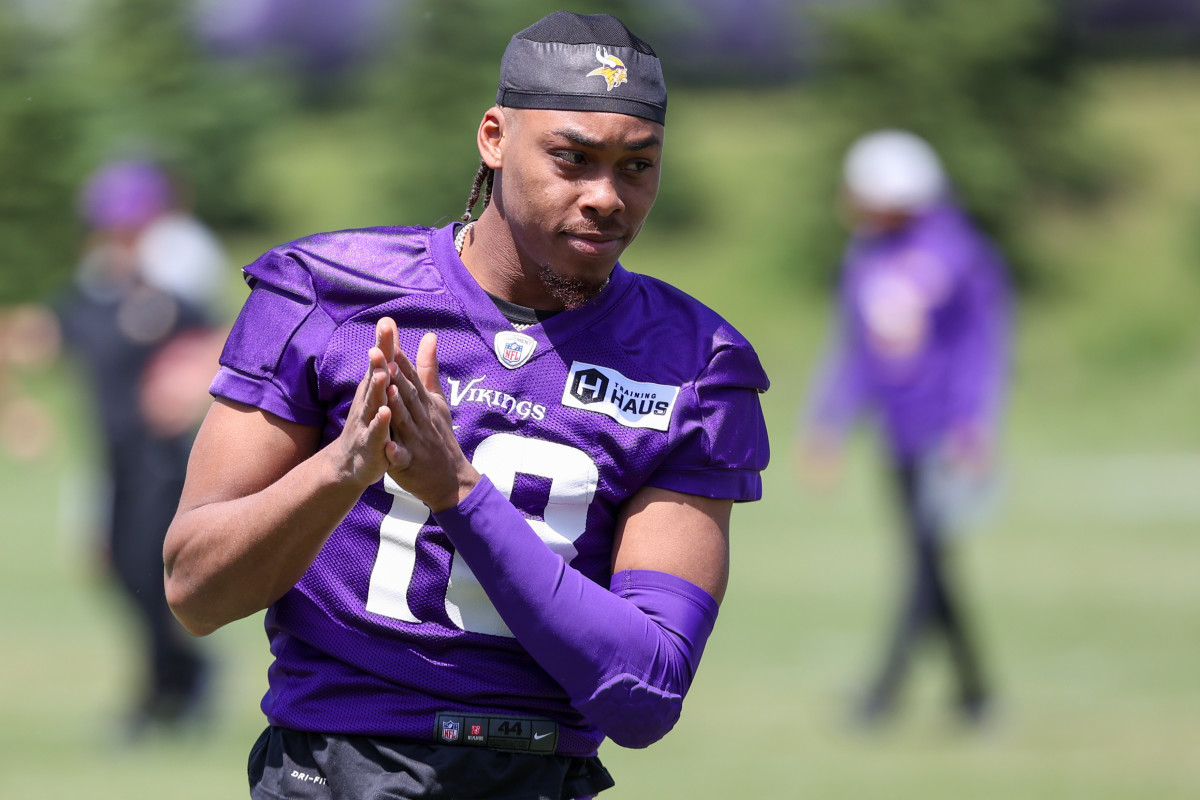How Big Will the Next Wide Receiver Contracts Go?
In taking a moment to catch our breath after the Receiver Market Explosion of 2022—which began in earnest last March when the Raiders traded Davante Adams for first- and second-round picks, and ended in July when the 49ers signed Deebo Samuel to a three-year extension worth $71,550,000—it’s fair to wonder what might happen for the next crop of receivers.
Specifically, that’s the financial futures of the Bengals’ Ja’Marr Chase and the Vikings’ Justin Jefferson. The two are younger than—and possibly better than—any of the receivers who dominated this offseason. If receiver market behavior mirrors that of most other robust positional markets, we’ll have a game of AAV (average annual value) leapfrog, with each deal slightly eclipsing the last. Receivers will also start to close the gap on quarterbacks in terms of total cap percentage faster than any other position. At the moment, only two nonquarterbacks have an AAV of $30 million or more: Rams defensive tackle Aaron Donald ($31.6 million) and Dolphins receiver Tyreek Hill ($30 million). Adams ($28 million) and Cooper Kupp ($26.7 million) both have higher AAV than Myles Garrett ($25 million), Khalil Mack ($23.5 million), Maxx Crosby ($23.5 million) and Trent Williams ($23 million), a collection of pass rushers and protectors who, before this summer, made up the list of the most well-compensated nonquarterbacks in football.
So we asked three NFL agents where they would place the monetary value of Chase’s and Jefferson’s second deals. Jefferson, who will be eligible for a contract extension next offseason, would obviously sign a deal before Chase, who can’t negotiate until after the 2023 season. (And, for the record, none of these agents represent Chase nor Jefferson.)

Here’s what the Jefferson and Chase contracts could look like, according to the agents:
• Agent A: $28–$30 million per year.
• Agent B: $30–$32 million per year, though the agent believed the market would crest at $32 million and did not see the position climbing much higher.
• Agent C: We are asking the wrong question. It’s not necessarily about the AAV when it comes to wide receivers, and it’s more about a period we may be entering when receivers, like quarterbacks, can start to inch closer to fully guaranteed contracts.
When we took the answer from Agent C and posed it to Agent B, the person’s reply: Why not both? A short-term deal worth roughly $32 million per season that is close to fully guaranteed.
Of the $71,550,000 that Samuel received from the 49ers, $58.1 million of that money would be considered a practical guarantee, as parsed out by Spotrac. This means that it’s more than likely Samuel will see most of that $58.1 million, or more than 81% of the total value of the contract. Kupp’s three-year, $80.1 million deal contained $75 million in practical guarantees, which means that it’s more than likely Kupp will receive close to 90% of the total value of the contract. Terry McLaurin signed a deal this offseason in which he is likely to receive close to 78% of the $68.3 million he signed for. And DK Metcalf should receive about 80% of his $72 million deal.
Compare that with Hill’s contract, for example. He’s more likely to see about 60% of his $120 million. A.J. Brown’s $100 million deal with the Eagles has about $57 million (57%) in practical guarantees. Christian Kirk, whose signing sparked a definitive signal that we were in a bustling receiver market, will get about half of the four-year, $72 million he signed for in terms of practical guarantees.
It’s here that we can separate a bit the contracts that made noise versus the contracts that made progress. (Some are, obviously, both.)
Agent B says of the quest for more guaranteed money: The Browns signing Deshaun Watson (five years, $230 million fully guaranteed) shined a light on how much owners could spend on a whim if they feel like it. Players know there is more up-front money out there.
Receivers, in particular, know the time to strike is now. While we wrote glowingly about an offense this offseason that doesn’t seem to care much about the position at all, receivers are now a highly coveted commodity for most GMs. We are in a golden age for the position, and receiver value seems to be recognized even when quarterback play is inconsistent (think McLaurin). Hill (paired with Tua Tagovailoa) will be a worthwhile test case this year. Adams (moving from Aaron Rodgers to Derek Carr) will be another.
So when Chase and Jefferson naturally try to one-up each other as the next heavy hitters at the bargaining table, will we see the market value soaring toward $40 million per year? Not if they’re smart. The real power play may be to eclipse Kupp, both in terms of his AAV ($80.1 million) and his percentage of money practically guaranteed. As of now, we are most certainly headed in that direction. The real question is whether more owners will stop pretending that the cash in their safes is exclusively reserved for those playing quarterback.
Watch NFL games this season with fuboTV: Start a free trial today!
More NFL Coverage:
